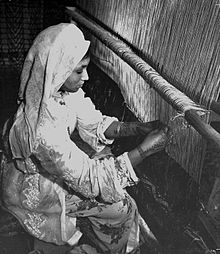 A Moroccan woman practicing the traditional weaving, Middle Atlas, 1955 | |
| General Statistics | |
|---|---|
| Maternal mortality (per 100,000) | 100 (2010) |
| Women in parliament | 11.0% (2013) |
| Women over 25 with secondary education | 20.1% (2012) |
| Women in labour force | 43.0% (2012) |
| Gender Inequality Index[1] | |
| Value | 0.425 (2021) |
| Rank | 104th out of 191 |
| Global Gender Gap Index[2] | |
| Value | 0.624 (2022) |
| Rank | 136th out of 146 |
| Part of a series on |
| Women in society |
|---|
 |
The history of women in Morocco can be divided into periods: before, during, and after the arrival of Islam.
After Morocco's independence from France, Moroccan women were able to start going to schools that focused on teaching more than simply religion, expanding their education to the sciences and other subjects.
Upon the institution of the legal code known as Mudawana in 2004, Moroccan women obtained the rights to divorce their husbands, to child custody, to child support, and to own and inherit property.[3] The law made progressive reforms on the status of women, but "substantial inequality and discrimination persist, particularly in unequal access to divorce for women, financial relationships between spouses, and child custody and guardianship."[4]
- ^ "Human Development Report 2021/2022" (PDF). HUMAN DEVELOPMENT REPORTS. Retrieved 19 December 2022.
- ^ "Global Gender Gap Report 2022" (PDF). World Economic Forum. Retrieved 1 March 2023.
- ^ "Women in Morocco". THIRDEYEMOM. 26 April 2011. Retrieved 9 November 2013.
- ^ Bordat, Stephanie Willman; Kouzzi, Saida (2023), Wing, Adrien K.; Kassim, Hisham A. (eds.), "Women's Rights in the Moroccan Family Code: Caught between Change and Continuity", Family Law and Gender in the Middle East and North Africa: Change and Stasis since the Arab Spring, Cambridge University Press, pp. 59–77, doi:10.1017/9781139151719.004, ISBN 978-1-107-02352-9